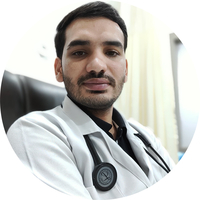An oxygen concentrator is a type of medical equipment that provides oxygen supply to patients whose O2 levels are lower than normal because either their lungs aren’t able to inhale enough oxygen or the inability of their body to circulate enough oxygen. The World Health Organization considers oxygen to be a basic requirement for the task of saving the lives of severely ill patients. It can be required by patients of any age, from infants to the elderly. Oxygen therapy via concentrators is often required for people with severe hypoxia, pulmonary edema, etc. Concentrators are often used for providing home care in situations where the condition of the patient is long-term or chronic.
- How an oxygen concentrator works
- Types of oxygen concentrators
- How to operate an oxygen concentrator
- Advantages of using oxygen concentrators
- Disadvantages of using oxygen concentrators
- Indications for oxygen concentrator use
- Oxygen concentrators for COVID-19 patients
How an oxygen concentrator works
Oxygen concentrators draw air from the environment to deliver concentrated oxygen. They can run continuously for five or more years and do not require extensive maintenance. They require a power source unlike some other methods of delivering oxygen like oxygen cylinders.
(Read more: Respiratory failure)
Types of oxygen concentrators
There are two main types of oxygen concentrators; stationary and portable.
- Stationary oxygen concentrators: Stationary concentrators may weigh around 10 kgs and have wheels to make their transport easier. The flow at which they provide oxygen can range from 5 LPM (litres per minute) to 15 LPM. They run on electricity. Depending on the model, they can be used to provide oxygen for multiple patients. They provide output at a lower cost compared to portable oxygen concentrators.
- Portable oxygen concentrators: Portable oxygen concentrators weigh between 1 to 4.5 kgs. Some models are battery-powered, making it easier to use them while travelling or where there isn’t a dependable power source. They provide oxygen supply at 3 LPM and are unlikely to be able to support multiple patients at the same time.
(Read more: Hypoxemia)
How to operate an oxygen concentrator
Different models of oxygen concentrators may operate differently. Refer to the instructions provided with the machine to set it up or consult an experienced technician to help you with it.
Usually, the following are the steps one need to follow to operate an oxygen concentrator:
- Plug the cord into the power outlet. Avoid using an extension cord.
- If your doctor has asked you to use the humidification bottle, fill it with distilled water and tightly screw it to the cap with the outlet tube.
- As per requirement, either attach the oxygen tube to the other outlet in the humidification bottle cap or attach an oxygen adapter to the concentrator outlet and then the oxygen tube to it.
- Turn the switch on. Leave the concentrator on for 10-15 minutes before using. Adjust the flow as recommended.
- Wear the mask or insert the two prongs of the nasal cannula into your nostrils and adjust the tube so it sits comfortably.
Advantages of using oxygen concentrators
Following are some of the advantages of using oxygen concentrators for oxygen therapy:
- They provide an unlimited supply of oxygen, unlike cylinders, given a consistent power source. They do not need to be taken elsewhere to be refilled.
- They are more cost-effective when needed for long-term use than some other methods.
- Whether stationary or portable, they are easier to transport compared to oxygen cylinders.
- They require a one-time installation only.
- While some regular cleaning by the user or caregiver is required, they do not require extensive maintenance.
Disadvantages of using oxygen concentrators
Following are some of the disadvantages of using oxygen concentrators for oxygen therapy:
- Regular use of nasal cannula can result in irritation in the nose.
- It is dependant on power supply at all times, which may be difficult to obtain in remote areas.
- A reserve compressed oxygen tank needs to be kept on hand in case of power failure.
- There is a warm-up period since the machine is turned on until it can be used.
- Filters may need to be changed pretty frequently.
- Some older models make noise and produce a vibration while operating.
- Water vapour in the room can compromise the functioning of the machine over time.
(Read more: Cannulation)
Indications for oxygen concentrator use
Your doctor could recommend the use of an oxygen concentrator for many different conditions, both chronic and acute.
- Chronic conditions like:
- Sleep apnea
- COPD (Chronic Obstructive Pulmonary Disease)
- Cystic fibrosis
- Acute conditions like:
- Asthma
- Pneumonia
- Respiratory distress syndrome
- Bronchopulmonary dysplasia
(Read more: Pneumonia and COVID-19)
Oxygen concentrators for COVID-19 patients
Normally, oxygen saturation (SpO2) levels are found to be between 95-100%. Those suffering from sleep apnea or lung disorders may have a slightly lower normal range. But when suffering from COVID-19, these levels can fall drastically low and lead to death. Keeping a check on oxygen levels with the help of a pulse oximeter has been recommended since the beginning of this pandemic. If you notice the levels starting to fall lower than 95%, even if you feel fine, you should seek medical advice as it can be an early indicator of needing oxygen therapy. If levels fall lower than 95%, seek emergency care as your situation could be critical.
Oxygen therapy can be provided in many ways, including through an oxygen concentrator. When liquid oxygen is in short supply due to a public health crisis, the demand for oxygen concentrators can rise exponentially. But, it’s important to remember that oxygen concentrators should be used only if your doctor advises you to and you should follow all of their instructions regarding use as well.
In many mild to moderate COVID-19 cases, oxygen concentrators may provide only a stop-gap until the patient can be admitted to the hospital. Severe cases often require high flow oxygen which cannot be provided by an oxygen concentrator.
Depending on the case, it may even be recommended during recovery from COVID-19.
(Read more: Complications of severe COVID-19)
Doctors for Oxygen concentrators

Dr. Rajesh Kumar
Internal Medicine
1 Years of Experience

Dr. Shubham Satsangi
Internal Medicine
7 Years of Experience

Dr Rahul
Internal Medicine
4 Years of Experience

Dr. C. Rajendran
Internal Medicine
19 Years of Experience
Medicines / Products that contain Oxygen concentrators
- Proctosedyl BD Cream - ₹108
- Anovate Cream - ₹140
- Pilo GO Cream - ₹80
- Covifor Injection - ₹3780
- Fabiflu 200 Mg Tablet - ₹1292
- Fabiflu 400 Tablet - ₹856
- Fabiflu (Favipiravir) 400 Mg Tablet - ₹1224
- Fabiflu (Favipiravir) 200 Mg Tablet - ₹1292
- Remdesivir Injection - ₹10500
- Molusafe Capsule - ₹457
- Movfor 200 Mg Capsule - ₹2490
- Molflu 200 Mg Capsule - ₹1400
- Molulife 200 Capsule - ₹1399
- Cipmolnu 200 Mg Capsule - ₹2000
- Molxvir 200 Mg Capsule - ₹1520
- Immunocin Alpha Plus 1.6mg Injection - ₹5998
- Alzumab Injection - ₹8229
- Imualfa 1.6mg Injection 1ml - ₹2628
- Molnutor 200 Mg Capsule - ₹2000
- Sotrovimab Injection - ₹165000
- Nirmatrelvir - ₹5000
- Molnupiravir 200 Mg Capsule - ₹1400
- Covihalt 200 Tablet - ₹465
- Ciplenza Tablet - ₹646
- Itolizumab Injection - ₹8220


















